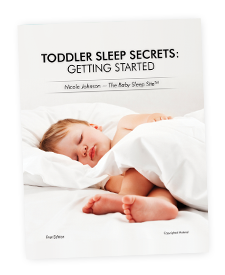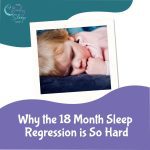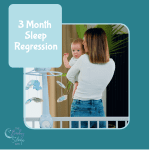
You might think that having a 2-year old at home means you can finally (FINALLY) kiss the exhaustion of sleep regressions goodbye. But sadly, you’d be wrong.
The truth is, there is one final sleep regression you’ll have to contend with when your child reaches around 24 months. You’ll have to tangle with the 2 year old sleep regression. Now, the good news is that this sleep regression is indeed the last! So once you get through this, you’re done navigating true sleep regressions. But the not-so-good news is that the 2 year old sleep regression can be a tough one to overcome if you don’t know how to deal with its unique sleep challenges.
2 Year Old Sleep Regression: 5 Reasons It Happens
1. Separation Anxiety – Separation anxiety can strike at any time, but there tends to be a resurgence of it around 2 years old. This separation anxiety can be based on actual fear. Your 2 year old may be afraid to be left alone, or with people he doesn’t know. However, it can also come from a desire not to miss out on the fun! If this separation anxiety surfaces as soon as you walk out the door during naptime and/or bedtime, it can disrupt your toddler’s sleep.
2. Disruptive Life Changes – There are several big, life transitions that tend to converge around the time your toddler is 2 years old. Specifically, many families of 2 year old toddlers are working on potty training. Or perhaps working on the transition to a big kid bed. In addition, some families are welcoming new babies around this time, too! These transitions, while natural, can cause major sleep disturbances.
3. Longer Awake Time – As your toddler grows, she needs progressively less sleep than she did as an infant. Most 2 year olds need approximately 12 hours of sleep in a 24 hour period, on average. Compare that to a newborn’s need for about 16 hours of sleep! And of course, most of your toddler’s sleep is happening at night now. You may also find that your 2 year old is showing more resistance to bedtime than usual. Perhaps she’s falling asleep late. Or, she may be waking too early. All this adds up to equal less downtime (and maybe less sleep!) for you.
4. Misleading “Nap Transition” – Around 2 years of age, some toddlers abruptly stop taking an afternoon nap. You might find that when you put your 2 year old down for her nap, she spends the entire hour talking/laughing/singing/playing. Or, you may find that your 2 year old’s nap resistance isn’t nearly so pleasant. She may spend the whole hour screaming! This sudden resistance to naps can come from your 2 year old’s desire not to miss out on anything. It can also be the result of her growing self-awareness and independence. She’s becoming more aware of what she wants. So, if she doesn’t want to lie down for a nap, she’s going to let you know it!
We advise parents to treat this sudden naptime resistance as a regression, and not as something permanent. Most children won’t completely give up their naps until 3 or 4. It’s best to simply stay consistent with your 2 year old’s schedule and routine, and to not give up on the nap just yet.
5. Nightmares, Night Terrors, and Nighttime Fears – By age 2, your toddler is becoming much more imaginative. This makes for really fun and entertaining play, but boy, can it ever be a problem at night! Most 2 year olds’ nighttime fears are triggered by the dark, and all the things that come with it — spooky shadows, monsters, etc. By this age, toddlers are growing more aware of the world and realizing that there are “bad guys” and things out there that can hurt them. These new nighttime fears can lead to things like nightmares, and even night terrors.
2 Year Old Sleep Regression: 5 Tips To Help You Cope
1. Offer comfort, but don’t form new (bad) sleep habits. If your toddler just won’t cooperate at bedtime, or is waking often at night, it’s fine to offer lots of comfort and cuddles. But avoid forming any new (bad) sleep habits that you’ll have to undo later. In general, be sure that your child is still falling asleep without much help from you, and is sleeping in her own sleeping space.
2. Consider putting off potty training or transitioning to a big kid bed. If you can tell that transitioning to a new bed or potty training is at the root of your 2 year old’s sleep regression issues, consider putting off the transition for a few months. It can be a great idea to wait and then try again later, when your toddler is a few months older.
3. Adjust your toddler’s schedule as necessary. If you need to incorporate more wake time in your child’s day, adjust the schedule so that you allow more time between the end of the afternoon nap and bedtime. You can shift the nap earlier or shift bedtime later to accomplish this.
4. Institute a rest time to deal with your 2-year old’s nap strike. If your 2-year old is on a nap strike, don’t rush to give up the afternoon nap. Instead, institute rest time. Put your toddler in bed with a few books and toys. Let him know that while it’s fine if he’s awake, he needs to stay in bed. This ensures that if he does get sleepy, he’s already well-positioned to fall asleep.
5. Give your 2-year old tools to cope with nighttime fears. Nightmares and nighttime fears are normal at this age. Fortunately, there are many ways to help your child cope with these fears. This 2-part blog series on nightmares and night terrors is a great resource. It lays out a number of strategies you can use to preserve your toddler’s sleep
 Want FREE sleep help that you can put to use right away? Download a copy of our free guide, Toddler Sleep Secrets! The guide is available to download instantly. This means you can start using the techniques in it as early as tonight. Download now, and learn why your toddler is waking at night and resisting naps! And learn what you can do about it and how!
Want FREE sleep help that you can put to use right away? Download a copy of our free guide, Toddler Sleep Secrets! The guide is available to download instantly. This means you can start using the techniques in it as early as tonight. Download now, and learn why your toddler is waking at night and resisting naps! And learn what you can do about it and how!








